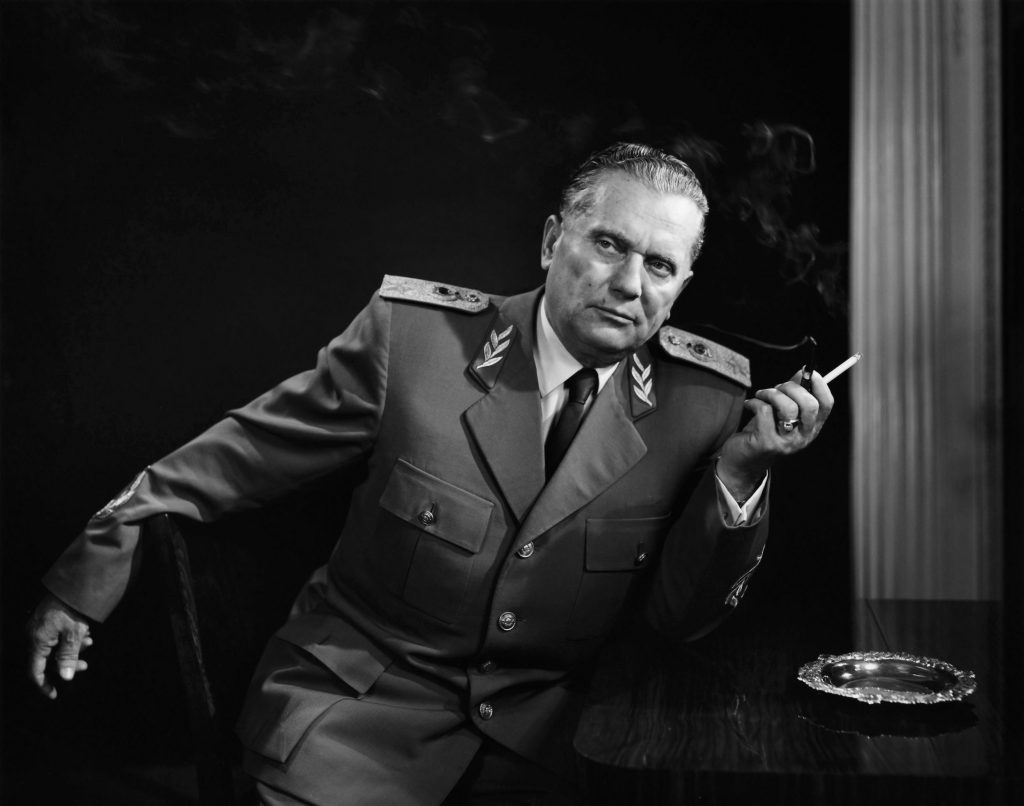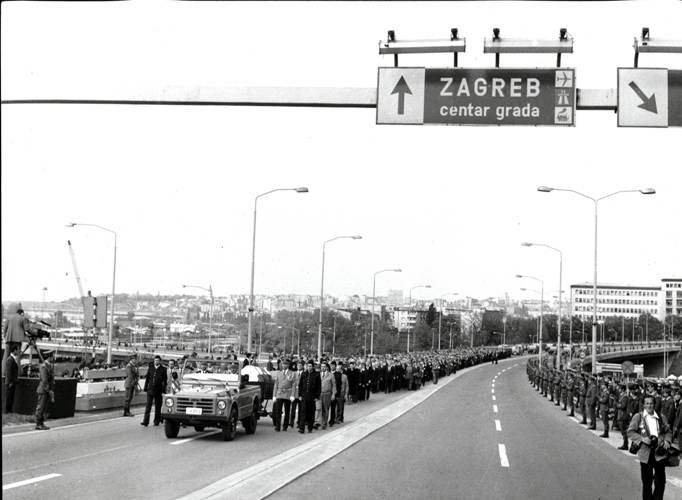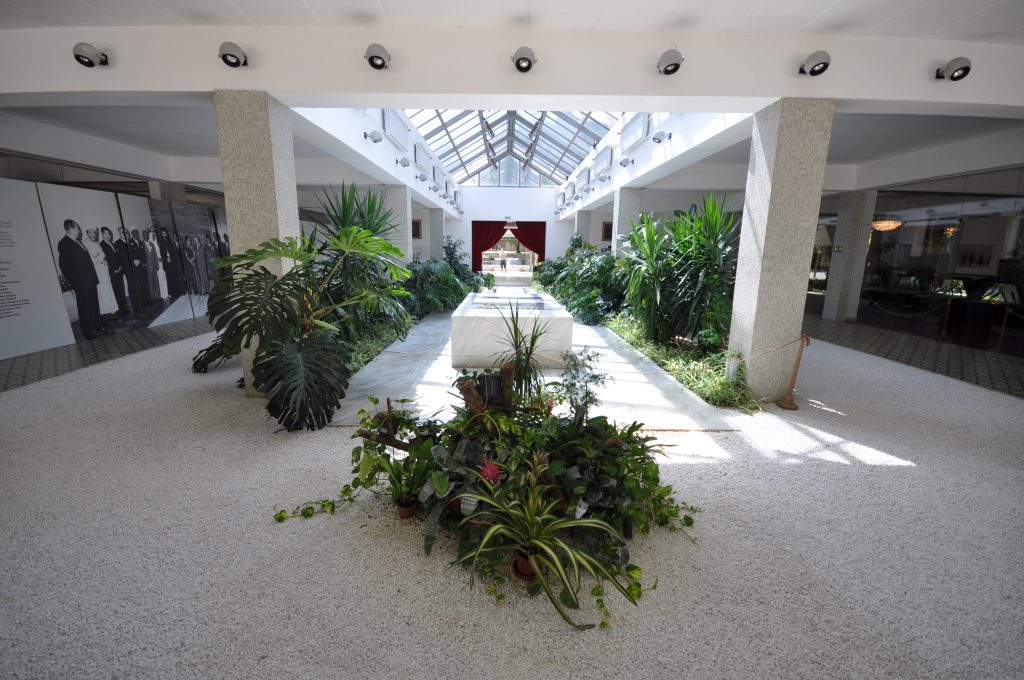It was the 4th of May, 1980. The place was the Socialist Federal Republic of Yugoslavia. The celebrations of International Workers Day are still fresh in your mind and you still feel like more festivities, so you go to the city of Split in Croatia to watch a football match at Poljud Stadium. You’re excited, the crowd is roaring, there’s smiles everywhere and at the 41st minute, three people run onto the pitch and signal the referee to stop the match. You’re frustrated, you’re angry! You wanted to see if your team would win! It was then that a man took the microphone and announced the holdup: Marshall Josip Broz Tito had died. Soon, the world’s largest state funeral would begin.
What follows is one of the grandest and most spontaneous cases of public mourning ever seen. Mass crying erupts through the crowd. Even the players break down, with one falling to the ground and sobbing uncontrollably. After some time to let the hysteria settle, the crowd of 50,000 suddenly erupts into the old patriotic song “Comrade Tito we swear to you, from your path we will never depart”. You might think this is an exaggeration, but much of it was filmed.
The grief of Tito’s passing soon spread through all of Yugoslavia and then, to the world at large. Because you see, Tito was not just a beloved statesman at home, he may well have been one of the most internationally popular leaders in history. When it came time for his state funeral, it was to become the largest in history, with more delegates than any other. For a country that no longer exists, which wielded comparatively small influential power when compared to America, the USSR, China and wherever else, it’s quite the accomplishment to have the world’s largest state funeral. So let’s first address why this happened before we talk about the event itself.
Why People Loved Tito

Within Yugoslavia itself, Tito’s popularity is almost obvious. When the Nazis invaded the then Kingdom of Yugoslavia, it was Tito who led the world’s largest partisan organization to fight the fascists back and expel them from the nation. It was Tito who then held democratic elections on a platform of brotherhood and the goal of a common Yugoslavia rather than exclusive ultranationalism, which led him to an overwhelming victory. And indeed, it was Tito who then refused to bow to pressure from Moscow and broke away to lead an independent Yugoslavia on its own course of socialism.
Of course this didn’t mean there weren’t people who hated Tito, indeed there was a pretty sizable population who fought him during the revolution, thousands of political prisoners served in labour camps and simmering nationalist anger was always there, but for many, it was hard to argue against the results. Yugoslavia was the only fully independent state in the eastern bloc (until Albania charted its own course) and its economy was booming much faster than many others. A key reason being that Tito did not outright denounce the Soviets, nor the west and was able to manipulate situations such that he received post-war aid from both. Another luxury not enjoyed by any other eastern bloc nation.
On the 26th of June 1950, Yugoslavia further pivoted away from the rest of the eastern bloc by passing a bill to start experimenting with handing over state-owned enterprises entirely to the employees, to be run on a basis of profit-sharing and workplace democracy rather than central planning. This became the dominant economic system, with state oversight of the economy limited. This put the Yugoslav economy in a strange equilibrium between socialism and capitalism (From a Marxist standpoint, this was functionally a different mode of capitalism.) In many ways, this allowed Yugoslavs to enjoy the ‘best of both worlds’, though it had drawbacks. Notably high unemployment and rapidly rising debt.
Tito gained further prestige by co-founding the Non-Aligned Movement and hosting their first conference in Belgrade in 1961. The non-aligned movement was what its name suggests, a movement of nations that neither completely supported the east or the west in the cold war. Suddenly, Tito’s influence was beyond Europe, it could be felt in Africa, in Latin America, in Asia and everywhere that nations were struggling to play a balancing act between the world’s warring great powers. Countries that may have cared little of the affairs of Yugoslavia now respected its leader who assisted them in their hour of need. So naturally their leaders attended the world’s largest state funeral.
In gaining the support of the west, Tito had gone against the Moscow line time and time again. During the Hungarian uprising, the leaders of the uprising sought shelter in the Yugoslavian embassy, where Tito refused to release them until they were assured safe passage. (The KGB went back on this deal and executed the leaders anyway, but Tito threatened to break off diplomatic ties entirely due to this.) Tito also condemned the Warsaw Pact invasion of Czechoslovakia and broadly lifted travel restrictions for his people, allowing westerners to enter Yugoslavia and Yugoslavs to enter the west. Indeed, by the 1970s, up to 20% of the country’s labour force was employed abroad, mostly in western Europe.
Tito’s Death and the World’s Largest State Funeral

When Tito finally passed away in 1980, it’s then perhaps easy to see why there was such a massive and uncontrolled outpouring of grief. For Yugoslavs, even those who hated him (and there were many dissidents) had to acknowledge high living standards, enormous international prestige and an utterly unique nation to live in. A formal week of national mourning was announced and plans were laid for what would become the world’s largest state funeral.
The world’s largest state funeral was held on the 8th of May, four days after Tito’s death. In those four days, the official attendees globally able to make the visit included four kings, thirty-one presidents, six princes, twenty-two prime ministers and forty-seven ministers of foreign affairs, with a total of 128 of 154 UN member states having some form of official presence. These delegates came from the east, the west and far beyond, with only a few staunch opponents and small countries not making their presence felt.
Every Warsaw Pact leader attended the world’s largest state funeral, including Leonid Brezhnev despite the Soviet Union’s antipathy to Yugoslavia. Hua Guofeng, the then leader of China personally attended as well, while US president Jimmy Carter failed to do so. Not attending actually got Carter quite a bit of criticism at home, resulting in him paying a visit to Tito’s grave the following month. The only European nation not to send a delegation was Yugoslavia’s next-door neighbour Albania, which contrasted with the rest of the world by vilifying Tito as an arch-revisionist and fascist.
The funeral proved a useful time for many state leaders to mingle and discuss important matters, while others went out of their way to avoid major international opponents and political rivals. An interesting result of just how diverse the world’s largest state funeral was. Indeed, you could see the leaders of East Germany meeting with those of West Germany, the leaders of India and Pakistan together, the prime minister of Japan in the company of Kim Il-Sung, Margaret Thatcher near Robert Mugabe and many more.
There were a few more… Bizarre attendees too. As befits the world’s largest state funeral. For one, Khieu Samphan was there. If you don’t know who he is, well, he was the official head of state for the Khmer Rouge, who legally ran Cambodia even though they’d been ousted for being genocidal psychopaths the previous year. (We’ve a few big articles on them), Achille Silvestrini who was a delegate from the Catholic Church. Which surely must have been awkward, when lots of the people around you are heads of state who clamped down on the church. Billy McKee, a founding member of the Provisional Irish Republican Army was also there for… Some reason, I’m sure.
Many leaders of international bodies attended too. The leaders of the Arab League, the European Parliament, the United Nations and more were present. A good few other revolutionary movements besides the IRA had delegations, with Yasser Arafat of the PLO being the most notable, along with Abdullah Öcalan of the Kurdistan People’s Liberation Army. Many international communist parties also sent their own delegations, though as many were pro-Moscow, one has to wonder if they attended out of solidarity with Tito, or for an opportunity to meet with the other attendees.
Tito was ultimately buried in a shallow grave in front of all these foreign dignitaries, then buried for a second time when everyone had left. The reason was firstly to prevent the body from being stolen and secondly, so they could put a massive 9-ton sarcophagus on top without making the world’s largest state funeral look ugly by having to bring a big crane in.
The Aftermath of the World’s Largest State Funeral

On the 16th of November, 1982, long after the world’s largest state funeral had ended, the funeral site was developed into the ‘Josip Broz Tito Memorial Centre’, which included an earlier established ’25th of May Memorial Museum’ and the ‘House of Flowers’ where Tito’s body was buried. In 1984, the ‘Memorial Collection Building’ put many of Tito’s state gifts on public display for all to see. While the museum complex was shut down as a result of the Yugoslav wars in the 90s, it has since re-opened and is a major tourist attraction.
The House of Flowers is so-called because while Yugoslavia was still in existence, the tomb was surrounded by flowers in tribute. Within, a simple marble stone marks Tito’s burial place. And just next to it, the burial place of Tito’s wife who was given a state funeral as late as 2013. Serbia in particular still seems to hold a lot of reverence for Tito and the legacy of the world’s largest state funeral definitely holds strong there.
Yugoslavia has passed into memory now and most of its constituent states aren’t the biggest fans of each-other anymore. Tito may have been lucky to die at the time he did. His economic policy set in motion the inevitable hyperinflation, austerity and economic collapse that buried Yugoslavia by the 1990s. He held back the tide of regional nationalism, but he could only do so for so long. His vision of Yugoslavia never truly survived, but by dying at such a high-point and with others to take the fall for Yugoslavia’s collapse, even those who fought to ruin the country he built may well be private supporters. Something made clear every May 25th, Tito’s birthday, when thousands visit to pay respects.
His legacy is preserved, with one of the jewels of that legacy being that for one gleaming moment, he held claim to the world’s largest state funeral.





